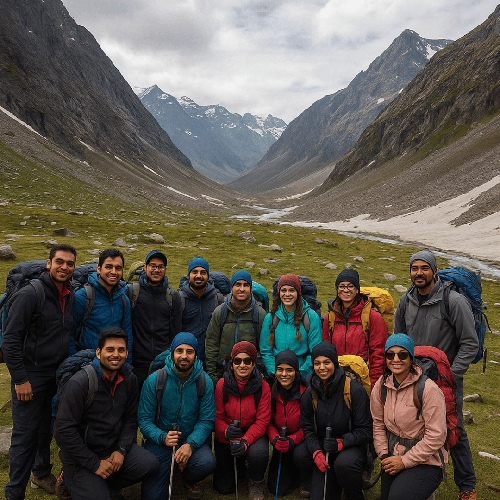HAMPTA PASS WITH CHANDRATAL LAKE
Hosted by TravelMite
- Verified Host
- Logout's Trusted
- Traveler's Choice
All About It
- 20 Slots
- Difficulty - Easy Moderate
- For 12+ years
- Best Season - Spring (Feb, March, April) Summer (May, June, July)
Hampta Pass Trek, located in the Kullu region of Himachal Pradesh, is situated at an altitude of 14,100 feet in the Pir Panjal range of the Himalayas. The diversity of the Hampta Pass trek lies in its route. You get to see the lush green pastures of Kullu, the peaceful charm of the Lahaul Valley, snow-capped peaks and beautiful lakes, along with colorful sunrises and sunsets, and the splendid Chandratal Lake all together in one package. This trek offers two different sides of the Himalayas: one side is lush green Kullu Valley, and the other side is desert Lahaul Valley. The views from here are spectacular during any season of the year, especially during the monsoon.
Manali is the starting point of the Hampta Pass trek, and it offers different varieties of landscapes along the pass. The other stunning places during the Hampta Pass trek, like Jobra, Chika, Balu Ka Ghera, Shia Goru, and Chhatru, are part of this route that connects the Manali Valley to Spiti Valley. Hampta Pass is a complete package with the number of changes and scenic views that the trail has to offer. It is called the "Gateway of Heaven" by the locals. The challenge comes when we climb to Chandratal Lake. Chandratal Lake is another level of beauty in the Spiti Region.
If you’re looking for a trekking peak with picturesque views, go nowhere but Hampta Pass Trekking. At just around 14,100 feet, it’s considered a minor pass in India—but it doesn’t stop anyone from enjoying its stunning beauty. The Hampta Pass trek distance is around 25 km, while the Manali to Hampta Pass distance is around 50 km, including.
The Hampta Pass Trek is a moderate-to-difficult-level trek with an altitude of 4,270 meters above sea level. The trek covers a distance of 26 kilometers, which takes around 5 days to complete. The terrain of the trek is diverse, ranging from rocky ridges, steep ascents and descents, and narrow paths. The weather conditions can be unpredictable, with sudden rain and snowfall and low temperatures at night. Several factors make the Hampta Pass Trek challenging. The steep ascents and descents, rocky terrain, and unpredictable weather can test the endurance and stamina of even the most experienced trekkers. Physical fitness is crucial for completing the trek, and regular exercise, such as cardio and strength training, can help prepare the body for the physical demands of the trek. Acclimatization is also essential, as the high altitude can cause altitude sickness, which can be life-threatening. Proper gear, such as sturdy trekking shoes, warm clothing, and a backpack, is necessary for the trek.
Hampta Pass Trek is a popular trekking destination in the Indian state of Himachal Pradesh. The trek offers a picturesque view of the Himalayan range and is a perfect blend of adventure and natural beauty. However the weather conditions during the Hampta Pass trek play a crucial role in determining the best time to do the trek. The ideal time to do the trek is between June and September, when the weather is pleasant and mostly dry. However, the monsoon season (July–August) brings heavy rainfall and landslides, making the trek difficult and risky. On the other hand, the winter season (October–May) brings extreme cold and snow, making the trek inaccessible. Therefore, it is advisable to avoid these seasons to ensure a safe and enjoyable trek.
Who should attend?
Hampta is known for its high altitude grasslands which you will cross on you trekking journey up to the highest point. Sometimes these patches of free and open land are used for the camping by the trekkers.The Hampta Pass trek in June is one of the best times to complete this trek. Considering the immense volume of snow and the sheer natural beauty, it is a must-do trek in June. Anyone with a little bit of daily excercise can join us on this exiciting journey to Hampta Pass.
Day 1 - Manali Campsite to Chika
Trek: 3 km
Duration: 3 hours
Altitude: 10
100 ft
Private Vehicle (Ertiga / Innova / Traveller)
Tents
Dinner
Once you arrive at Manali base camp, After the briefing session, we will drive from Manali Basecamp to Jobra village, where the trek starts. From Jobra, the hike starts in Chika. Dinner and stay overnight.
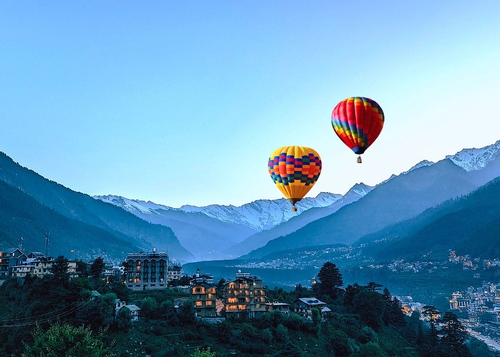
Manali
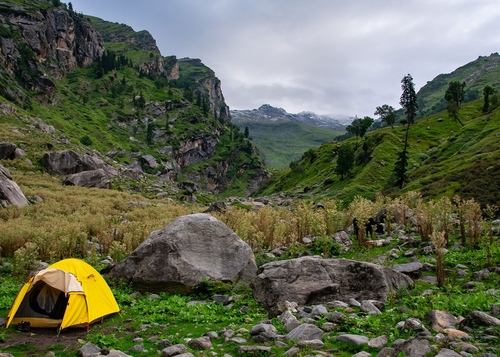
Hampta Base
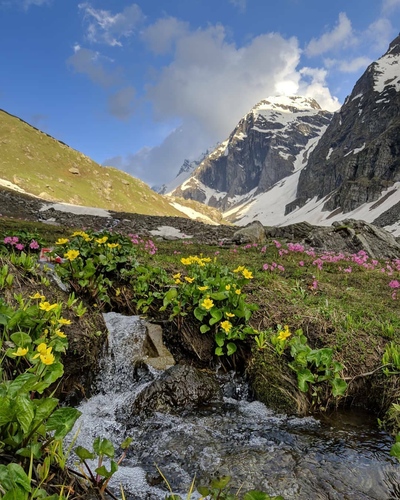
Jobra
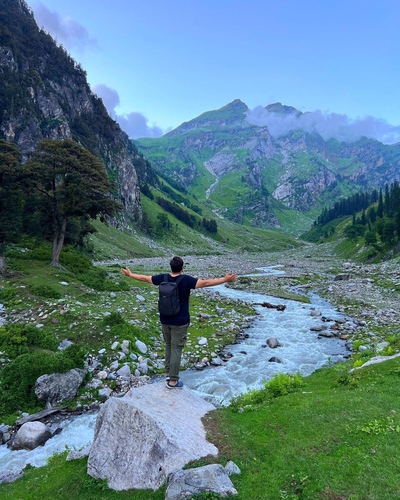
Chika
Day 2 - Chika to Balu Ka Ghera
Duration: 5 hrs
Altitude: 12
100 ft
Private Vehicle (Ertiga / Innova / Traveller)
Tents
All Meals
After having breakfast, we'll begin our hike from Chika to Balu Ka Ghera (named because of the territory of bears), since it's the hibernating place for bears in winter. The trek will again be filled with challenges and picturesque scenes as we cross different rivers and streams and experience the blossoms of nature. Thus, it'll be best to leave the climax scene to the trekkers only.
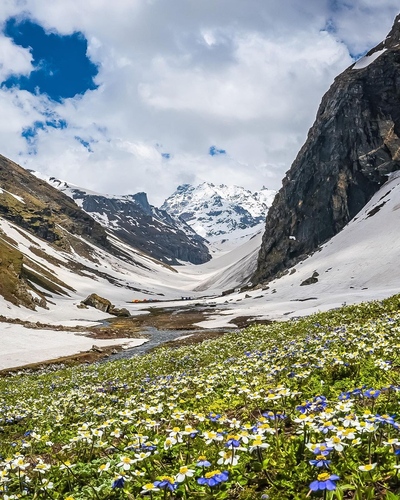
Balu Ka Ghera
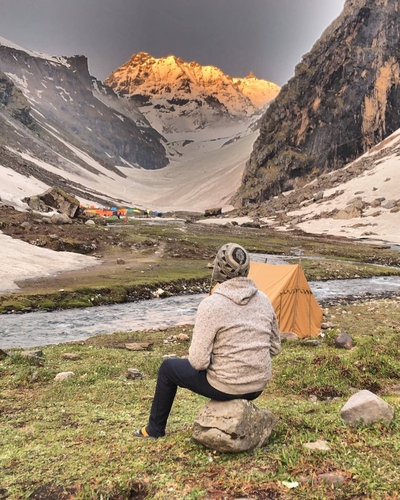
Campsite
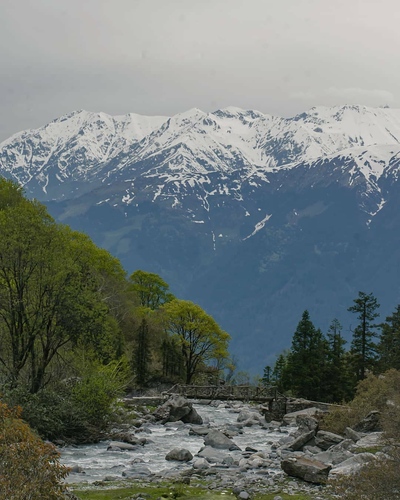
Chika
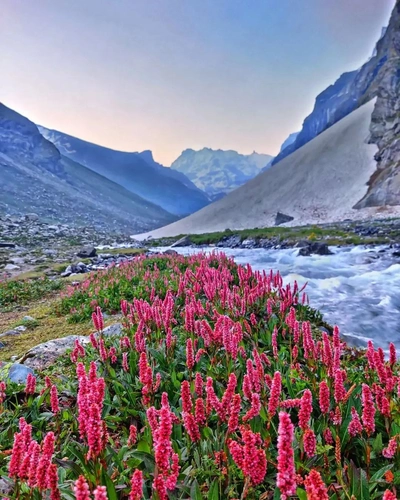
Flora
Day 3 - Balu Ka Ghera to Hampta Pass and further to Shia Ghoru
Duration: 8 hrs
Altitude: 14
100 ft
Private Vehicle (Ertiga / Innova / Traveller)
Tents
All Meals
On day 3 of the Hampta Pass Trek with Chandratal, we might aim to leave the campsite by 7 AM because the trek ahead is long and somewhat tedious. It will be a very adventurous day, and we can see the variety of flowers on the whole trail. We'll go from Balu ka Ghera to Shia Ghoru, which is at 12,900 feet. It'll take approximately 4-5 hours to succeed at Hampta Pass (14,000 feet), and from there, another few hours to descend to Shia Ghoru. There will be a steep descent to reach the Shia Ghoru camp site, where you will enjoy a beautiful sunset from Hanuman Tibba Peak.
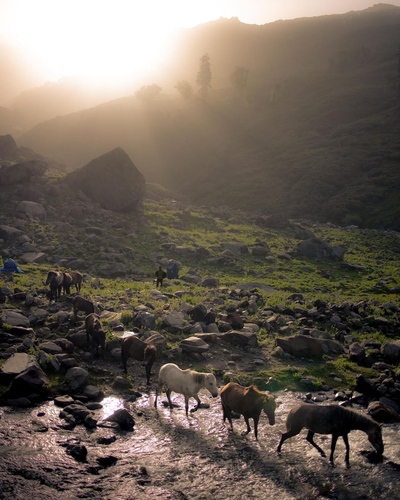
Hampta Pass
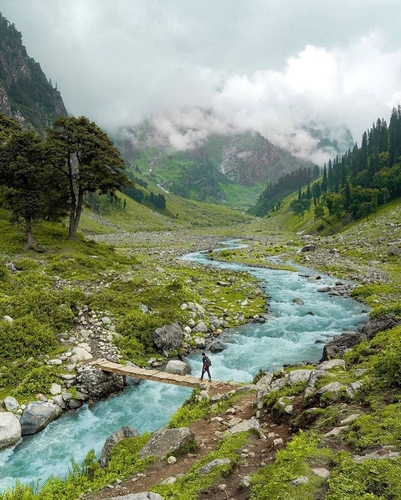
Hampta
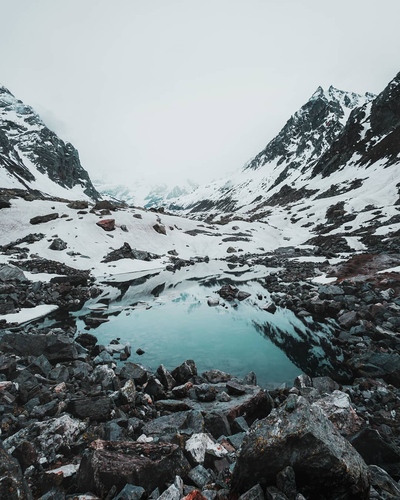
Siagoru
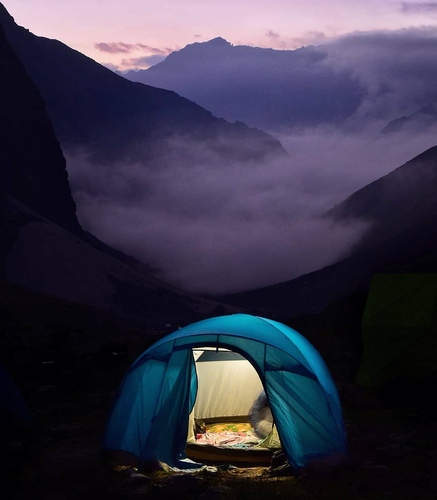
Camps
Day 4 - Shia Ghoru to Chhatru, drive to Chandratal, and back to Chhatru Campsite
Trek: 5 km
Duration: 8–9 hours
Altitude: 12
300 ft
Private Vehicle (Ertiga / Innova / Traveller)
Tents
All Meals
Today we are heading towards Chhatru, and often it is the place that will offer us the most breathtaking and unforgettable views of the valleys of Lahaul and Spiti. The Spiti and Pir Panjal ranges will add to the splendor and magic of this place. Chhatru is the focal point of three places, namely Hampta Pass, Rohtang Pass, and Spiti Valley. This stretch of the trek will be followed by a jeep ride to Chandratal, which is believed to be the place from which Yudhishthira, the eldest Pandava, went to heaven. If the weather is favorable, you will be camping in Chhatru. The trail will be slippery on this day. Snowfall can be seen at the beginning of summer. After the summer, only patches of snow will be available.
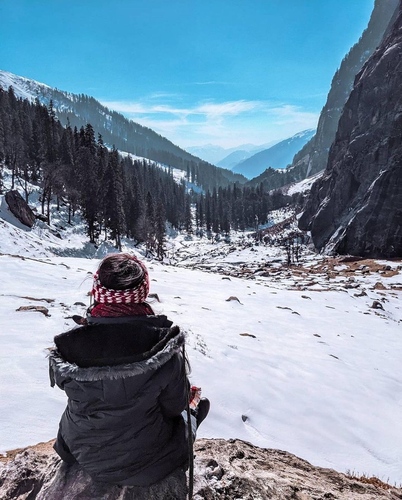
Hampta
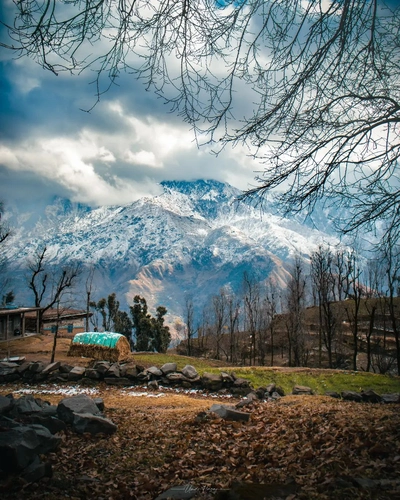
Pir Panjal Ranges
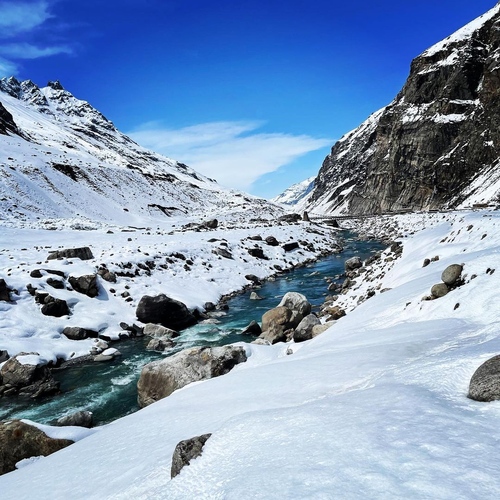
Chhatru
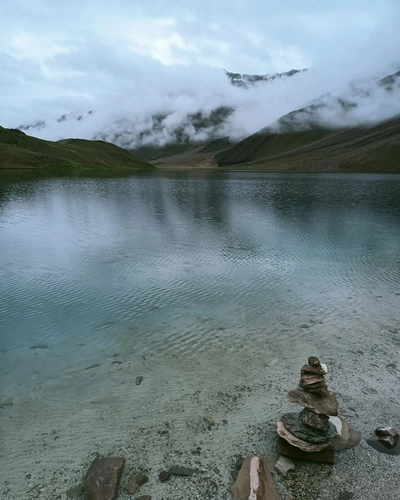
Chandratal
Day 5 - Jeep Ride from Chhatru to Manali Base Camp
Duration: 4.5 hrs
Altitude: 6
730 ft
Private Vehicle (Ertiga / Innova / Traveller)
Stay Not Applicable
Breakfast
The last day of this adventurous trip will begin early, as we'll be covering tons today. We'll aim to leave Chhatru by 8–9 AM after having breakfast. Our first stop would be Manali, which we'll reach by lunchtime after crossing the Atal Tunnel. Although we are keeping Manali's arrival time at around 5 p.m. on the safer side
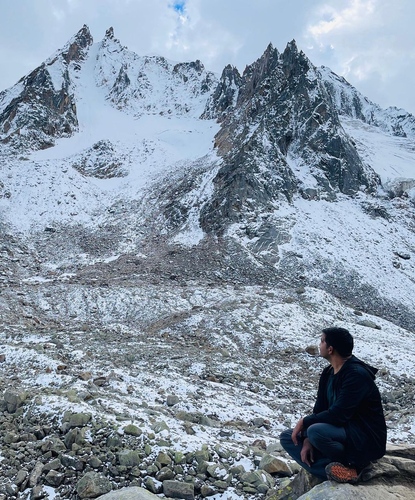
Hampta Pass
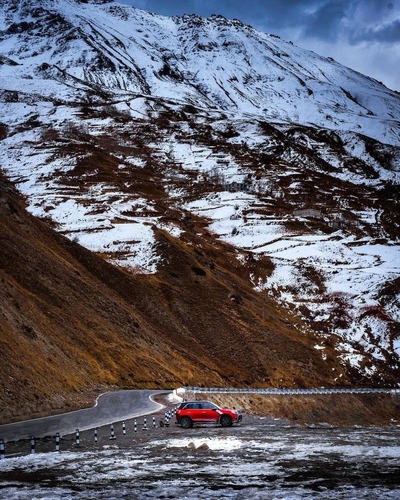
Lahaul Spiti
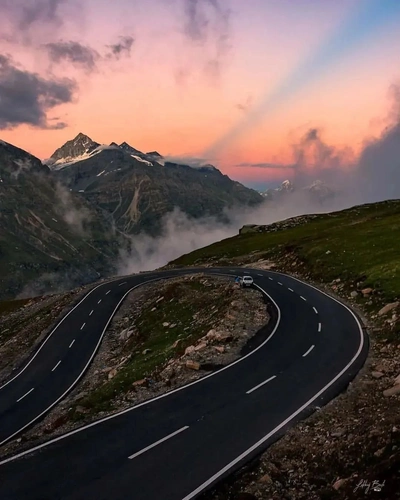
Rohtang Pass
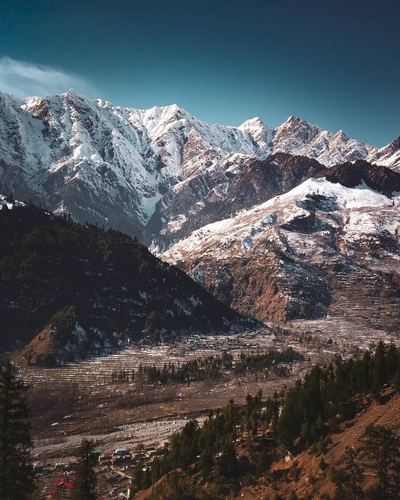
Manali
Meet your host

TravelMite
- Verified Host
- Logout's Trusted
- Traveler's Choice
TRAVESSED – An Obsession with Travel A single word, yet it perfectly captures the heartbeat of our philosophy. When your mind drifts to memories of past adventures and your heart races at the thought of the next one—you’ve truly been TRAVESSED. Who We Are ? At TravelMite, we’re not just trip planners—we’re memory makers. Since 2018, we’ve been crafting immersive, meaningful, and unforgettable travel experiences. From thrilling treks to soulful stays, we curate journeys that leave a lasting impact—across India and far beyond. Based in the tranquil beauty of Uttarakhand, TravelMite is your one-stop hub for adventure and exploration. Whether you're a high-altitude hiker, a thrill-chasing backpacker, or a wanderer seeking connection through culture—we’ve got the perfect path for you. Why Choose TravelMite ? 🌍 Tailored Experiences Whether you're after a budget-friendly escape or a luxury expedition, we offer travel styles to suit every traveler. 🛡️ Safety Meets Sustainability We partner with India’s top-rated operators to ensure every trip is safe, eco-conscious, and seamless. ⛰️ Adventures Unlimited From glacier hikes and jungle safaris to paragliding and river rafting, we bring the wild to life. Explore motorbike expeditions, spiritual sojourns, or head overseas for vibrant Southeast Asian escapes. 👣 Led by Real Travelers Our team consists of true globetrotters—those who’ve roamed the world, designed remarkable itineraries, and guided thousands on their dream journeys. Our Promise With 7+ years of experience and a growing family of 48,000+ happy travelers, we’re proud of our reputation for excellence. Our glowing reviews on Google, Facebook, and more reflect our dedication to thoughtful service, smooth operations, and sustainable travel. Join the Adventure Whether you're looking to meet fellow wanderers, rediscover yourself, or set out on a life-changing expedition—TravelMite is your gateway to the extraordinary. From the majestic Himalayas to the sun-soaked coasts of Southeast Asia, your next unforgettable story starts here. 📩 Connect with us today—and let’s turn your wanderlust into lifelong memories.
See TravelMite's other listingsInclusions
- Accommodation in alpine and dome camps is shared.
- Meals include from Day 1 lunch to the last day breakfast. Meals will be simple and vegetarian, primarily (Breakfast, lunch, evening tea and snacks, and dinner).
- Crampons (spikes for shoes) and gaiters for snow trekking.
- Professional and experienced certified trek guide.
- Transportation from Manali to Manali: first day drive from Manali to Jobra, fifth day drive from Chhatru to Manali.
Exclusions
- Anything not mentioned in the inclusions above.
- Any kind of personal expenses during the trip or out of any emergency/medical exigency.
- Any personal trekking gear (like trekking pole, trekking shoes, poncho, gloves, warm cap, bag, jacket etc).
- Mules or porters to carry personal luggage.
- Any kind of Insurance
Things to carry
- Rucksack & Day Bag pack - Make sure your backpack has good hip support, shoulder support, and quick access pockets.
- A day bag pack will help you carry your tiffin box , water bottle and mobile while trekking.
- Trekking Shoes- Shoes that are sturdy, have good grip, have ankle support, and can handle snow.
- Woollen clothing - including thermal pants and shirts, a pair of woollen gloves, woollen and sun caps, 3 pairs of woollen socks, a woollen scarf, thick jackets, etc.
- At least 1 litres of bottled water and instant food like cookies and cakes.
- Necessary toiletries like hand sanitizers, towels, napkins, etc.
- Extra plastic bags
- Sunglasses and lip balms.
- Waterproof rucksack and rain cover for rucksack.
- Medical kit, including any prescribed medicines
- Torch with fresh batteries
- Relevant trekking and camping gear like trekking shoes, trekking backpack, trekking poles, etc.
- Power Bank
- Raincoat
- Extra Pair of Slipper
- Tiffin Box for pack lunch(If opted)
- Medication( if any prescribed by doctor)
HOW TO REACH
How to Reach Manali:
By Road: Manali is well connected to Delhi. Take an overnight bus from Delhi and you will reach Manali in 12 ‐ 14 hours (approx 540 km).
By Train: The nearest Railway station is Joginder Nagar railway station 163 km from Manali. From here, you can reach Manali by Private and Sharing cab, taxi, or bus; it takes approximately 4-5 hours.
By Air: The nearest airport is Kullu Manali Airport in Bhuntar is 50 Kms. Taxi services are available from Bhuntar to Manali.
Policy and more
- We understand that plans change sometimes. If you need to amend a guaranteed reservation, please do so latest by 12 noon, 30 days prior to arrival, to avoid amendment charges. 100% non-refundable should there be any cancellation/amendment within 30 days of arrival.
- For all bookings, where the guests don’t show up/ they choose to check-out early, the complete booking will be non-refundable.
- Booking amount is non refundable.
- No cancellations will be taken over the call or WhatsApp message. Please reply to the email of email confirmation that you have received at the time of booking regarding the cancellation.
- There would be no refund provided in case some problems occur due to government orders, harsh weather conditions, protests, landslides, or any delay due to other/any unforeseen circumstances. On the occasion of any such happenings, we have a backup plan ready most of the time and we'll be moving onto that. There are times when we would have to cancel some activities mentioned in the itinerary but it's only due to the reason that we would be bound by a circumstance that is not in our control. Any extra charges incurred because of the changes would be borne by the guests.
- If a trek is called off at the last moment due to a natural calamity/unforeseen circumstances (like rain, snowfall, earthquake, landslides, strike, bandh, etc.) then the participants would be provided with a travel voucher for the same amount that can be used within 3 months of the issuance date for any package worth the same amount. (Subject to availability)
- If a trek/trip has to be aborted midway due to a natural calamity/unforeseen circumstances (like rain, snowfall, earthquake, landslides, strike, bandh, etc.). In that case, no refund would be provided.
- Travelmite will not bear any extra expense due to any natural calamity/unforeseen circumstances (like rain, snowfall, earthquake, landslides, strike, bandh, etc.).
Terms and Conditions
IDENTITY PROOF
- In keeping with Government regulations, we request all guests (on single/double/triple occupancy) to carry a photo identity to present on check-in. Foreign nationals are required to present their valid passport and visa. Indian nationals can present any government issued photo identity address proof card e.g. driving license, passport, Aadhar card or voter’s ID card. PAN Card will not be accepted as the above. Also do keep handy proof of corporate affiliations, if you have made a corporate booking.
NO SMOKING
- The Government of India has introduced a ‘no smoking’ rule for hotels, restaurants and all public places. This means smoking is prohibited in all parts of the campsite except in designated areas.
PAYMENT POLICY
- 50% payment at the time of Confirmation. Balance payment upon 24 hours prior to arrival .
- Please note that the room/s and the rate will be confirmed subject to availability, at the time of receipt of the advance deposit details.
Frequently Asked Questions
- What is the best time for Hampta Pass Trek?
One of the biggest assets of the Hampta Pass trek is that it can be covered at roughly any time of the year.
However, to derive maximum utility from the trek, it is advised to cover it between June and September. The average temperature during this time is an average of 13 to 18 degrees during day time and it drops to about 0
degrees at night. In September, the temperature drops below 0. June is one of the months in which Hampta Pass has patches of snow, thereby making it an excellent snow-trekking experience.
- What is the level of fitness expected from the participants?
Hampta Pass’ trek difficulty is between easy and moderate. A little trekking experience from beforehand can go a very long way, and maintaining an optimum level of fitness is recommended. A medical check-up before the trek is also advisable.
- What are the clothing and equipments that need to be carried from our end?
The following essentials should be carried for the Hampta Pass trek:
Clothing - Full sleeve shirts/T-shirts, track-pants, cotton socks, woolen socks, full sleeved sweater or fleece jacket (preferable), one light jacket, thermal inners, gloves, sun-cap, scarf, and trekking shoes.
Equipment - Head-light/flashlight with extra batteries, walking stick, and a backpack with rain cover.
Additional and miscellaneous – Insulated water bottle, towel, lip balm, cold cream, sun-screen (SPF 40+ recommended), toiletries and toilet paper, personal medicine kit, and dark sunglasses (U/V protected).
- Which type of shoes should I carry?
Normal sports shoes are not suitable for trekking. They can be carried to wear at the campsites. For the purpose of trekking, a strong pair of shoes from Woodland or Forclaz 500 are recommended.
- What kind of food will be provided during this trek? What about safe drinking water?
Healthy, vegetarian meals that facilitate easy mobility in the mountains are a part of the trekking package from
Day 1 to Day 4. The menu is simple and includes items like bread and butter, poha and sandwiches for breakfast; as well as rotis/puris with vegetable curry for lunch. Dinner mostly consists of rice, roti, dal and a dessert every day. Tea, biscuits and other snacks are also included. However, trekkers are advised to carry energy-building
foods like nuts and energy bars from their end as well. Potable water will not be a problem because we cross many water resources on the Hampta Pass trek. Carrying two liters of water per day is advisable.
- What is the Cost of Hampta pass trek?
The cost of the Hampta Pass trekking package begins from INR 8,500 per adult, where a 30% discount is applicable. Group bookings can enjoy an additional bonus discount. The most suitable time to trek to Hampta Pass is between June and September, because the winter months witness a lot of snow, due to which trekking activities are not allowed during that time. This package includes meals, transfers, guide, stay, and other amenities. It is advisable to select the best available package that includes all of these things, for the trekkers’ convenience.
- How much weight will I have to carry?
A backpack with a capacity of at least 6L is a necessity. However, any additional weight depends on your luggage and capacity.
- Will there be mobile connectivity?
There will be a few places where mobile connectivity will be available. However, for most of the trekking period, you will not find mobile connectivity while covering the Hampta Pass trek.
- How to reach Hampta Pass?
The first step towards getting to Hampta Pass is reaching the Hampta Pass base camp. Our base camp for this trek is Jobra, which is at a distance of about 18 Km away from Manali. It will take about two hours to cover that distance via road. After reaching the base camp at Jobra, the trek up to Hampta Pass is a two-day affair. You will be covering a distance of about 35 km on foot (walking and hiking) for the duration of the trek.
- What about first aid and medicines?
Medical and first aid kits are a preexisting part of the Hampta Pass trekking package. A basic medical kit and devices like oxygen cylinders and oxi-meters are a part of the trek cost and tour guides are well-trained to handle first-aid situations. Other than this, if you have a specific medical condition, you will have to carry your own medicines and requisites for the same.
- How difficult is Hampta Pass Trek?
The Hampta Pass Trek lies between easy and moderate difficulty. What makes it so is the change in atmospheric pressure with the rise in altitude. The weather conditions also add to the difficulty level. On this trek, you will be
traversing a maximum altitude of 14,100 feet and will pass through areas of abundantly thick vegetation.
- Can I have liquor or smoke while we're on the trek?
No, the act of smoking and drinking is prohibited on the trek. Since the places here are at high altitudes and even breathing seamlessly is an issue, smoking is out of the question. Consumption of alcohol is not allowed during
the whole trail either, as it may cause nausea and vomiting. Both these activities can let your body dehydrate easily, which makes it incredibly difficult to cover the desired distances easily.
- How is Hampta Pass Trek weather?
The weather depends heavily on the time of the year you choose to trek to Hampta Pass. In the months of June and July, the day temperature ranges from 13 to 18 degrees, and it falls between 0 and 7 degrees at night. In
September, the climate gets much colder, and both days and nights witness relatively much lower temperatures. Quite astonishingly, the snowfall will last at some spots of the trek till the first few days of July.
- Is Diamox is advisable?
Diamox is a must-have medicine to prevent Acute Mountain Sickness or discomfort from the change in altitude. It is advisable to keep some handy. You will be trekking to a height of more than 14,000 feet and 10-12 tablets of
Diamox are great to have around in case of any emergencies, and to keep queasiness at bay.
- How do I get in shape?
Since the Hampta Pass trek is not the easiest trek to embark on, and requires you to cover many forest ranges, areas of high altitude and rough terrains, it is advisable to follow a good cardio routine at least a couple of weeks before the trek, so as to build your endurance and maintain your fitness levels. These cardiovascular exercises will not only get your heart pumping, they will also add to your lung-capacity, in terms of the amount of oxygen it can take in. One can start with jogging and increase the speed and distance covered with each day.
Flexibility-intensive exercises like stretching, squats and swimming also go a long way.
- What are washroom/toilet facilities like on the trek?
At each campsite, there will be separate toilets arranged for men and women. The number of toilets set up depends largely on the number of members present in the group. Toilet-tents consist of a deep pit, a mound of soil and a shovel to cover it up. Mostly, the toilets available while trekking are dry and you will be required to use toilet paper only. Room fresheners will be provided.
- How long is Hampta pass Trek?
The Hampta Pass trek is a length of 35 km, and covers the breathtaking fragments of the Dhauladhar range. The trek starts at Manali. You are taken from Manali to Jobra via road, and then from Jobra (base camp site) to Chika, which is located at an elevation of 10,000 feet above ground. The second day involves trekking to Balu ka Ghera
for around 5 hours. The view of the snow-capped mountains is what makes this part of the trek incredibly satisfying. On the last day, you will be heading to Siagoru, which is your last camping destination for this trek. From here, a drive to Chandratal Lake is what brings the whole experience full circle.
- Is Hampta pass safe?
Yes, the Hampta pass trek is a safe trek. However, light rains during the monsoon season can make the trek slightly difficult. Trekking to Hampta Pass is prohibited in the winter months because of the heavy snow. This trek is also safe for solo-travelers because the trails are well-defined and there have been no unsafe events of avalanches, etc.
- Is Hampta pass open in December ?
No, the Hampta Pass trek route is completely sealed off in December because of the heavy snow making it a virtually impossible route to follow. In addition to this even the roads and passes are closed during this time, for the same reason. It is advisable to go on other Himalayan treks during this time, like the Kedarkantha trek.
- Can I do the Hampta Pass trek in February or March?
No , you cannot do Hampta Pass trek in February or March! As these are the winter months for Hampta pass
there is deep snow all over the region and trekking is almost impossible. At this time, not only the trekking routes but the roads are also closed due to snow. The favorable months for this trek is from June to October as there is hardly any snow and the views of the Chandra Valley are just beyond one’s imagination.
- Can I do the Hampta Pass trek in Winter?
No, it is not possible to cover the Hampta Pass trek in the winter months because the entire valley is covered with snow and all the roads are blocked. Connectivity is very weak during this time, making it an inaccessible trek. In
these months, you can cover the Kedarkantha trek instead.
- Can I go to Hampta Pass in August?
Planning for the Hampta Pass trek can be problematic in August because it The terrain becomes slippery but the entire valley revives with the onset of monsoons. If you are planning the trek in this month then you need to be an experienced trekker as the routes are not that easy for a first-timer.
- How is Hampta Pass Trek in October?
In the month of October, the charm of the Lahaul and Spiti valley increases because the forests are surrounded by glacial beauty and the views are simply breathtaking. October marks the commencement of winters at Hampta Pass. The temperature drops very low during this time. While there is snow fall, there is no rain, making it a great
time to trek this region. The temperature at the beginning of the month is 15 degrees and drops down to -2 degrees by the end.
- What is the total trekking distance of the Hampta pass trek?
The total trekking distance you will cover while making your way to Hampta Pass is about 35 km (on foot). The circuit of the trek is: Manali - Jobra – Chika- Balu ka Gera – Siagoru - Hampta Pass - Siagoru - Chatru –
Chandratal Lake - Manali. The entire trek takes about six days and five nights. It is advisable to check in with guides about the weather conditions of the area before going for the trek.
- Why Hampta Pass is the best trek in mid-June?
Mid-June is the best time to trek to Hampta Passs, because of the constancy of clear skies and beautiful, snow-capped peaks. The temperature ranges between 5 and 15 degrees, which makes it a doable trek for this
time. The vegetation is mostly alpine, with clusters of deodars here and there that fringe the route upwards. The sunshine is warm and pleasant, and makes it quite an amazing place to trek. Since the weather conditions are
excellent during these months, it is the best time to trek to Hampta Pass if you are a beginner.
- How to reach Hampta Pass from Delhi?
Hampta Pass is at a total distance of 634 Km from New Delhi. To reach the pass, you need to start your journey from Delhi to reach the starting point of the trek, which is in Manali. The distance between Delhi and Manali is about 536 Km, and can be covered via overnight flights or by travelling via luxury buses or cabs.
- Is there snow in Hampta Pass?
Yes, Hampta Pass is snow-clad from mid-June to July. Afterwards, the snow melts completely in the month of August, and remains so till November. The winter months of December and January also witness extremely low temperatures. It is not advisable to trek to Hampta Pass during this time.
- Is Hampta Pass easy?
The Hampta Pass trek is between easy and moderate. It is located at an altitude of 4,270 metres, and the trek itself is very dynamic because the rough terrain varies with each day. It is important to note that the air pressure and altitude can make the trek a little difficult. If there is snow present, you may have some difficulty in walking through it. However, a lot of seasoned trekkers, as well as beginners, succeed in finishing this trek.
- Is the trek safe for solo female travellers?
The Hampta Pass trek is pretty safe for solo female travelers. You are accompanied by a professional trek leader, a guide as well as the necessary staff to support you due course the endeavour. Moreover, this is a
group-oriented journey, and you will not be alone. You will, quite possibly, encounter more solo female trekkers and enjoy the experience together.
- Will we get safe drinking water on Hampta Pass trek?
Potable frinking water and other similar activities are a part and parcel of the trekking package. It is important to carry an insulated, reusable water-bottle that can be filled with water before you begin.
- Will I get any porter to carry my luggage?
The Hampta Pass trek package includes an experienced trip leader, well-informed guide, and adequate support staff to help you with your luggage and other services throughout. It is also advisable to pack light and only carry essentials during the main trek.
More From TravelMite
[[ event.name ]]
[[event.duration]]
From [[price.price | number:0]]
From [[event.price | number:0]]
Free
[[ batch.startdate|date]] [[batch.soldout ? ' (Soldout)':'']]

